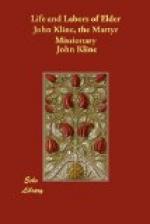FRIDAY, August 20. This day Brother Kline started to Pendleton County, Virginia. From Pendleton he went to Hardy County, and from there to Hampshire County. He filled every appointment made for him by the Brethren to whom he had written on July 2. On his outward way he left a line of appointments which he filled on his return homeward. On this tour he traveled 183 miles on the back of his faithful mare Nell, over roads and mountain paths next to impassable. He was gone from home on this trip just two weeks, in which time he preached nineteen sermons, attended one council meeting and one love feast.
Such preaching tours, as this work abundantly shows, were but common proofs of his missionary spirit and love for the souls of men. Added to this we find a purely unselfish spirit in him. Not long before his martyrdom he told me that if he would have asked for money along the lines of his work extending over many years—using his very words—“I know that I would have freely received it; but I have never asked one cent; and, God prospering me in the future as in the past, I never expect to.” He went on his own expenses, always and at all times, apparently more ready to give than to receive.
THURSDAY, September 30. On this day Brother Kline started to Tennessee. He rode Nell. He went up the Valley of Virginia, stopping with Brethren and preaching by previous arrangements made by letters. He stayed all night with Peter Nininger, and one night with Benjamin Moomaw. At both places he filled appointments previously sent on.
MONDAY, October 4. He dined at Jacob Brubaker’s. He arrived at Brother John Bowman’s on Friday, the eighth.
SATURDAY, October 9, he had meeting at John Bowman’s. It would seem that he had leisure here to jot the outlines of his discourse on that day. He spoke from Rev. 2:7. TEXT.—“He that hath an ear, let him hear what the Spirit saith unto the churches.”
There is a wonderful correspondence of natural things with things spiritual. It is this correspondence which makes a good life give evidence of a good heart within, and intelligent conduct prove that it is the offspring of an enlightened mind. If there were no correspondence between internal and external things—between the tree and its fruit—what would we know about anything? It is from this law that all our Lord’s parables and miracles derive their significance. When he spoke of external, natural things, he wanted his disciples to learn internal, spiritual things. In the text he speaks of a hearing ear. “He that hath an ear.” Do not nearly all men have ears? In several other places the Lord says: “He that hath ears to hear, let him hear.” It is plain that the natural ear is not meant; but the ear of the soul (by which is meant an understanding mind) is the ear meant in the text. But to hear means more than just to understand what is said. People may understand what they hear or read, and still be none the better off for it. To hear, in a divine sense, is to hearken; and to hearken means to obey, or a willingness to obey. The text then means about this: “He that understands what the Spirit saith to the churches, let him obey.” This brings up the question whether or not people of ordinary intelligence are able to understand what the Spirit says to the churches.




